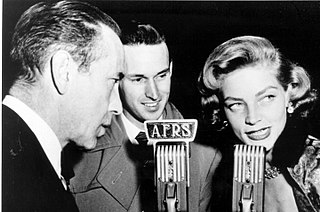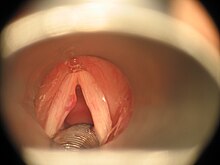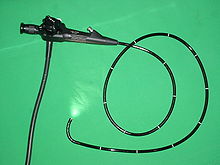
The human voice consists of sound made by a human being using the vocal tract, including talking, singing, laughing, crying, screaming, shouting, humming or yelling. The human voice frequency is specifically a part of human sound production in which the vocal folds are the primary sound source.
Vocal cord nodules are bilaterally symmetrical benign white masses that form at the midpoint of the vocal folds. Although diagnosis involves a physical examination of the head and neck, as well as perceptual voice measures, visualization of the vocal nodules via laryngeal endoscopy remains the primary diagnostic method. Vocal fold nodules interfere with the vibratory characteristics of the vocal folds by increasing the mass of the vocal folds and changing the configuration of the vocal fold closure pattern. Due to these changes, the quality of the voice may be affected. As such, the major perceptual signs of vocal fold nodules include vocal hoarseness and breathiness. Other common symptoms include vocal fatigue, soreness or pain lateral to the larynx, and reduced frequency and intensity range. Airflow levels during speech may also be increased. Vocal fold nodules are thought to be the result of vocal fold tissue trauma caused by excessive mechanical stress, including repeated or chronic vocal overuse, abuse, or misuse. Predisposing factors include profession, gender, dehydration, respiratory infection, and other inflammatory factors.
Vocal fold cysts are benign masses of the membranous vocal folds. These cysts are enclosed, sac-like structures that are typically of a yellow or white colour. They occur unilaterally on the midpoint of the medial edge of the vocal folds. They can also form on the upper/superior, surface of the vocal folds. There are two types of vocal fold cysts:
- Sub-epithelial vocal fold cysts- located in the superficial lamina propria of the vocal folds.
- Ligament vocal fold cysts- located within the deeper layers of the lamina propria or on the vocal ligament.

Reinke's edema is the swelling of the vocal cords due to fluid (edema) collected within the Reinke's space. First identified by the German anatomist Friedrich B. Reinke in 1895, the Reinke's space is a gelatinous layer of the vocal cord located underneath the outer cells of the vocal cord. When a person speaks, the Reinke's space vibrates to allow for sound to be produced (phonation). The Reinke's space is sometimes referred to as the superficial lamina propria.

Laryngitis is inflammation of the larynx. Symptoms often include a hoarse voice and may include fever, cough, pain in the front of the neck, and trouble swallowing. Typically, these last under two weeks.

Laryngectomy is the removal of the larynx and separation of the airway from the mouth, nose and esophagus. In a total laryngectomy, the entire larynx is removed. In a partial laryngectomy, only a portion of the larynx is removed. Following the procedure, the person breathes through an opening in the neck known as a stoma. This procedure is usually performed by an ENT surgeon in cases of laryngeal cancer. Many cases of laryngeal cancer are treated with more conservative methods. A laryngectomy is performed when these treatments fail to conserve the larynx or when the cancer has progressed such that normal functioning would be prevented. Laryngectomies are also performed on individuals with other types of head and neck cancer. Less invasive partial laryngectomies, including tracheal shaves and feminization laryngoplasty may also be performed on transgender women and other female or non-binary identified individuals to feminize the larynx and/or voice. Post-laryngectomy rehabilitation includes voice restoration, oral feeding and more recently, smell and taste rehabilitation. An individual's quality of life can be affected post-surgery.

Bogart–Bacall syndrome (BBS) is a voice disorder that is caused by abuse or overuse of the vocal cords.
A hoarse voice, also known as dysphonia or hoarseness, is when the voice involuntarily sounds breathy, raspy, or strained, or is softer in volume or lower in pitch. A hoarse voice can be associated with a feeling of unease or scratchiness in the throat. Hoarseness is often a symptom of problems in the vocal folds of the larynx. It may be caused by laryngitis, which in turn may be caused by an upper respiratory infection, a cold, or allergies. Cheering at sporting events, speaking loudly in noisy situations, talking for too long without resting one's voice, singing loudly, or speaking with a voice that's too high or too low can also cause temporary hoarseness. A number of other causes for losing one's voice exist, and treatment is generally by resting the voice and treating the underlying cause. If the cause is misuse or overuse of the voice, drinking plenty of water may alleviate the problems.
"Voice therapy" or "voice training" refers to any non-surgical technique used to improve or modify the human voice. Because voice is a social cue to a person's sex and gender, transgender people may frequently undertake voice training or therapy as a part of gender transitioning in order to make their voices sound more typical of their gender, and therefore increase their likelihood of being perceived as that gender. Having voice and speech characteristics align with one's gender identity is often important to transgender individuals, whether their goal be feminization, neutralization or masculinization. Voice therapy can be seen as an act of gender- and identity-affirming care, in order to reduce gender dysphoria and gender incongruence, improve the self-reported wellbeing and health of transgender people, and alleviate concerns over an individual being recognized as transgender.

Contact granuloma is a condition that develops due to persistent tissue irritation in the posterior larynx. Benign granulomas, not to be confused with other types of granulomas, occur on the vocal process of the vocal folds, where the vocal ligament attaches. Signs and symptoms may include hoarseness of the voice, or a sensation of having a lump in the throat, but contact granulomas may also be without symptoms. There are two common causes associated with contact granulomas; the first common cause is sustained periods of increased pressure on the vocal folds, and is commonly seen in people who use their voice excessively, such as singers. Treatment typically includes voice therapy and changes to lifestyle factors. The second common cause of granulomas is gastroesophageal reflux and is controlled primarily through the use of anti-reflux medication. Other associated causes are discussed below.

Speech–language pathology is a field of healthcare expertise practiced globally. Speech–language pathology (SLP) specializes in the evaluation, diagnosis, treatment, and prevention of communication disorders, cognitive-communication disorders, voice disorders, pragmatic disorders, social communication difficulties and swallowing disorder across the lifespan. It is an independent profession considered an "allied health profession" or allied health profession by professional bodies like the American Speech-Language-Hearing Association (ASHA) and Speech Pathology Australia. Allied health professions include audiology, optometry, occupational therapy, rehabilitation psychology, physical therapy and others.
Vocal cord paresis, also known as recurrent laryngeal nerve paralysis or vocal fold paralysis, is an injury to one or both recurrent laryngeal nerves (RLNs), which control all intrinsic muscles of the larynx except for the cricothyroid muscle. The RLN is important for speaking, breathing and swallowing.
Spasmodic dysphonia, also known as laryngeal dystonia, is a disorder in which the muscles that generate a person's voice go into periods of spasm. This results in breaks or interruptions in the voice, often every few sentences, which can make a person difficult to understand. The person's voice may also sound strained or they may be nearly unable to speak. Onset is often gradual and the condition is lifelong.
Puberphonia is a functional voice disorder that is characterized by the habitual use of a high-pitched voice after puberty, hence why many refer to the disorder as resulting in a 'falsetto' voice. The voice may also be heard as breathy, rough, and lacking in power. The onset of puberphonia usually occurs in adolescence, between the ages of 11 and 15 years, at the same time as changes related to puberty are occurring. This disorder usually occurs in the absence of other communication disorders.
Godfrey Edward Arnold, born as Gottfried Eduard Arnold, was an Austrian American professor of medicine and researcher. His studies centered on speech, speech disorder and clinical communicology.
Vocal cord dysfunction (VCD) is a pathology affecting the vocal folds characterized by full or partial vocal fold closure causing difficulty and distress during respiration, especially during inhalation.
Richard Luchsinger (1900–1993) was a Swiss medical doctor who made early contributions to the field of Speech Language Pathology, specifically in "phoniatry" or the study of voice. He was born in Switzerland and specialized in otorhinolaryngology. His most notable contribution to the field of voice was a textbook that he published with Dr. Gottfried E. Arnold. The textbook was originally published in German, however the second edition, published in 1965, was translated into English under the title: Voice-Speech-Language.
Speech and language impairment are basic categories that might be drawn in issues of communication involve hearing, speech, language, and fluency.
Thyroplasty is a phonosurgical technique designed to improve the voice by altering the thyroid cartilage of the larynx, which houses the vocal cords in order to change the position or the length of the vocal cords.
Muscle tension dysphonia (MTD) was originally coined in 1983 by Morrison and describes a dysphonia caused by increased muscle tension of the muscles surrounding the voice box: the laryngeal and paralaryngeal muscles. MTD is a unifying diagnosis for a previously poorly categorized disease process. It allows for the diagnosis of dysphonia caused by many different etiologies and can be confirmed by history, physical exam, laryngoscopy and videostroboscopy, a technique that allows for the direct visualization of the larynx, vocal cords, and vocal cord motion.










